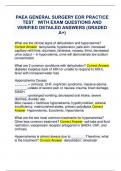PAEA GENERAL SURGERY EOR PRACTICE
TEST WITH EXAM QUESTIONS AND
VERIFIED DETAILED ANSWERS (GRADED
A+)
What are the clinical signs of dehydration and hypovolemia?
Correct Answer tachycardia, hypotension, pale skin, increased
capillary refill time, dizziness, faintness, nausea, thirst, decreased
urine output -- in hypovolemia, urine will demonstrate low sodium
concentration
What are 2 common conditions with dehydration? Correct Answer
diabetes insipidus (lack of ADH or unable to respond to ADH),
fever with increased water loss
Hyponatremia Causes
_______ = cirrhosis, CHF, nephrotic syndrome, massive edema
_______=states of severe pain or nausea, trauma, brain damage,
SIADH
_______=prolonged vomiting, decreased oral intake, severe
diarrhea, diuretic use
Misc causes = factitious hyponatremia, hypothyroidism, adrenal
insufficiency, malnourished states, primary polydipsia Correct
Answer Hypervolemic, Euvolemic, Hypovolemic
What are the two most common treatments for hyponatremia?
Other less common treatment? Correct Answer salt tabs and fluid
restriction; vasopressin receptor antagonist in SIADH, CHF, and
cirrhosis
Hypernatremia is almost always due to _______. Therefore, what
is the treatment? Correct Answer dehydration; rehydrate!
,What s/s can result in a hyperkalemic patient? Correct Answer
cardiac arrhythmias (tall peaked T waves) and weakness
If the potassium level is above 6meq/L or the patient has EKG
changes, what treatments can lower K temporarily? Correct
Answer calcium gluconate, sodium bicarbonate, insulin and
glucose, kayexalate (takes longer to be effective)
______&______ is extremely effective in decreasing potassium.
Correct Answer Dialysis and furosemide
Hypokalemia is usually due to ________, hypomagnesemia,
alkalosis, high aldosterone levels. How is it treated? Correct
Answer potassium loss; replacement must be slow!!!
Mild loss: oral KCl supplements or K containing foods
Severe loss: IV supplementation - rate 10mEg/hr
Causes of ________are VITAMIN D METABOLIC DISORDERS,
abnormal PTH function, primary hyperparathyroidism, Lithium,
malignancy, disorders related to high bone turnover rates
(hyperthyroidism, prolonged immobilization, thiazide use, vit A
intoxication, Pagets dz of bone, multiple myeloma), renal failure
Correct Answer hypercalcemia
How should hypercalcemia be treated? Correct Answer fluid and
diuretics, bisphosphonates, and calcitonin
_______is usually caused by ineffective PTH (chronic renal
failure, absent active vit D, ineffective active vit D,
pseudohypoparathyroidism), deficient PTH. Correct Answer
Hypocalcemia
How should hypocalcemia be treated? Correct Answer
intravenous calcium gluconate, Tums
,Increased CO2, hypoventilation, or decreased pH is aka ___.
Correct Answer respiratory acidosis
Decreased CO2, hyperventilation, or increased pH is aka ___.
Correct Answer respiratory alkalosis
Increased H+ or HCO3 loss, DKA, lactic acidosis is aka ___.
Correct Answer metabolic acidosis
Loss of H+ is aka ________. Correct Answer metabolic alkalosis
The d/d of post op ___________can be MI, atelectasis,
pneumonia, pleurisy, esophageal reflux, PE, musculoskeletal
pain, subphrenic abscess, aortic dissection,
pneumo/chyle/hemothorax, or gastritis. Correct Answer chest
pain
Who classically gets silent MI's? Correct Answer diabetics
How should syncope be initially evaluated? Correct Answer It is
important to distinguish syncope from cardiac arrest from other
nonsyncopal conditions causing LOC
Syncope d/d: Prodrome or aura usually associated with ____.
Correct Answer seizures (as is loss of continence)
Cardiac syncope's onset is usually ____without a prodrome.
Monitor vitals regularly, EKG, orthostatic challenge, neuro exam
etc. Correct Answer sudden
In a surgery patient with dyspnea on exertion, what should be
ruled out? Correct Answer PE or pneumothorax
, What are some chronic dyspnea on exertion causes? Correct
Answer asthma, COPD, interstitial lung disease, myocardial
dysfunction, obesity
What are some acute dyspnea on exertion causes? Correct
Answer angioedema, anaphylaxis, foreign objects, airway
trauma, pulmonary infection, pleural effusion, peritonitis/ruptured
viscous, bowel obstruction
__________is pain, cramping, or both of the lower extremity
(usually calf muscle) after walking a specific distance; then
resolves for a specific amount of time while standing. Correct
Answer Claudication
What is claudication associated with? Correct Answer peripheral
vascular occlusion
D/D of lower extremity claudication? Correct Answer
neurogenic/nerve entrapment/discs, arthritis, coartation of the
aorta, popliteal artery syndrome, neuromas, anemia, diabetic
neuropathy pain
A _________is an abnormal dilation of an artery. Involve all layers
of the arterial wall. Correct Answer aneurysm
At what size is surgical repair of aneurysm recommended?
Correct Answer 5.5 cm
95% of aneurysms are associated with ___________. Correct
Answer atheroschlerosis -- other causes are trauma, infection,
syphilis, & Marfan's syndrome
What is the classic triad of s/s related to ruptured AAA? Correct
Answer abdominal pain, pulsatile abdominal mass, hypotension




